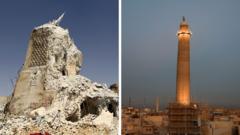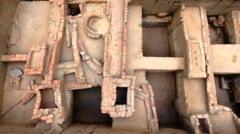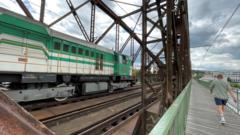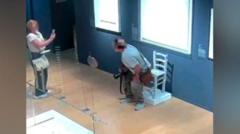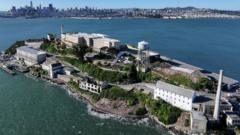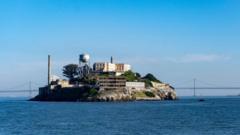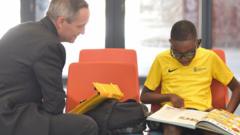Mosul, once a vibrant symbol of inter-religious harmony in Iraq, is witnessing the revival of its historical landmarks following the devastating impacts of the Islamic State (IS) group's takeover from 2014 to 2017. Notably, churches, mosques, and notable structures have begun to reopen, thanks to an extensive restoration project coordinated by Unesco, which started a year after the city's liberation in 2017.
A significant ceremony to commemorate the reopening will take place, with Unesco's director-general, Audrey Azoulay, attending alongside local artisans, residents, and representatives from various religious communities. The scars left by IS during their brutal occupation are still visible, but the community is forging ahead, celebrating the restoration of cultural identity and community bonds.
IS imposed a wave of destruction across Mosul, culminating in extensive damage during the liberation battles led by a US-backed coalition. Photographer Ali al-Baroodi recalls the shocking sight of what remained when he returned to the Old City—his beloved al-Hadba minaret, a crucial symbol of the city for centuries, lay in ruins, evoking a sense of loss and despair.
With 80% of the Old City destroyed, the challenge of reconstruction has been immense. Unesco has mobilized around $115 million, mainly sourced from the United Arab Emirates and the European Union. Religious leaders, like Dominican priest Father Olivier Poquillon, emphasize that rebuilding physical structures is only part of the process; restoring trust among the diverse communities living in Mosul is equally vital.
The project not only aims to repair buildings, including the renowned al-Hadba minaret and the convent of Notre-Dame de l'Heure, but also to foster community engagement. Over 1,300 young locals have been trained in traditional skills, and thousands of jobs have been created, significantly impacting the lives of those involved. The reconstruction efforts emphasize cultural identity, especially for younger generations growing up amid conflict.
Eight years post-liberation, sounds of life are returning to Mosul. The bells of al-Tahera Church ring out once more, marking a notable step towards renewal. Residents like Mustafa, whose family home dates back to 1864, share excitement over returning to their restored homes, a testament to the enduring spirit of the city.
While Mosul remains fragile, its resurgence represents a glimmer of hope for future unity and resilience, as its people work together to heal and rebuild their beloved city. "It's like seeing a dead person coming back to life," says al-Baroodi, encapsulating the transformative journey of Mosul's rebirth and the indomitable spirit of its inhabitants.
A significant ceremony to commemorate the reopening will take place, with Unesco's director-general, Audrey Azoulay, attending alongside local artisans, residents, and representatives from various religious communities. The scars left by IS during their brutal occupation are still visible, but the community is forging ahead, celebrating the restoration of cultural identity and community bonds.
IS imposed a wave of destruction across Mosul, culminating in extensive damage during the liberation battles led by a US-backed coalition. Photographer Ali al-Baroodi recalls the shocking sight of what remained when he returned to the Old City—his beloved al-Hadba minaret, a crucial symbol of the city for centuries, lay in ruins, evoking a sense of loss and despair.
With 80% of the Old City destroyed, the challenge of reconstruction has been immense. Unesco has mobilized around $115 million, mainly sourced from the United Arab Emirates and the European Union. Religious leaders, like Dominican priest Father Olivier Poquillon, emphasize that rebuilding physical structures is only part of the process; restoring trust among the diverse communities living in Mosul is equally vital.
The project not only aims to repair buildings, including the renowned al-Hadba minaret and the convent of Notre-Dame de l'Heure, but also to foster community engagement. Over 1,300 young locals have been trained in traditional skills, and thousands of jobs have been created, significantly impacting the lives of those involved. The reconstruction efforts emphasize cultural identity, especially for younger generations growing up amid conflict.
Eight years post-liberation, sounds of life are returning to Mosul. The bells of al-Tahera Church ring out once more, marking a notable step towards renewal. Residents like Mustafa, whose family home dates back to 1864, share excitement over returning to their restored homes, a testament to the enduring spirit of the city.
While Mosul remains fragile, its resurgence represents a glimmer of hope for future unity and resilience, as its people work together to heal and rebuild their beloved city. "It's like seeing a dead person coming back to life," says al-Baroodi, encapsulating the transformative journey of Mosul's rebirth and the indomitable spirit of its inhabitants.

